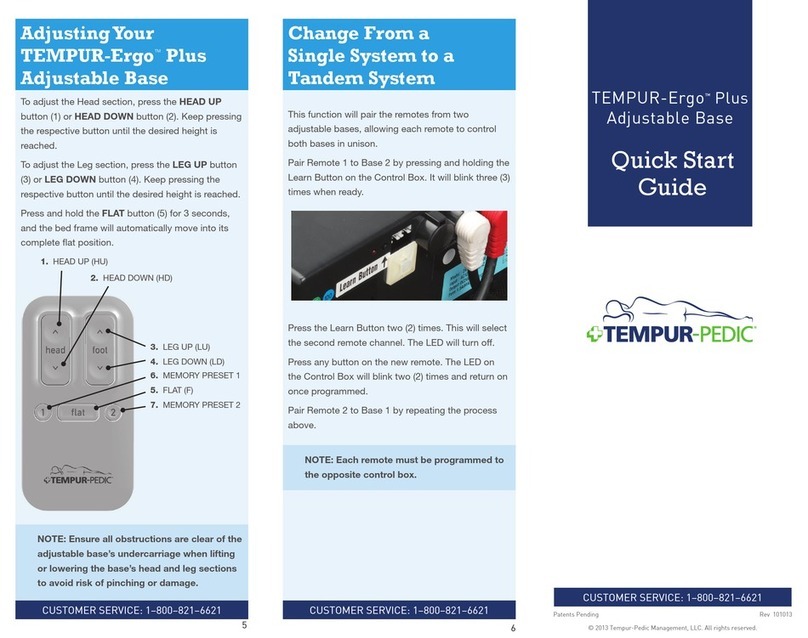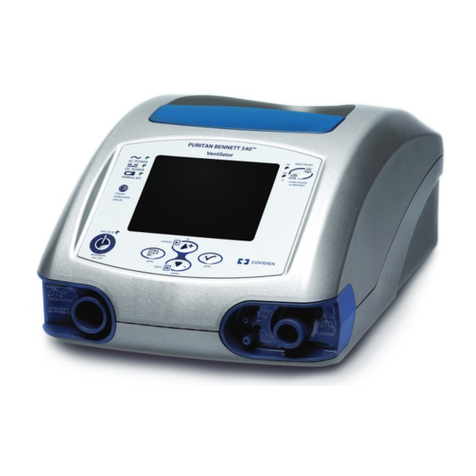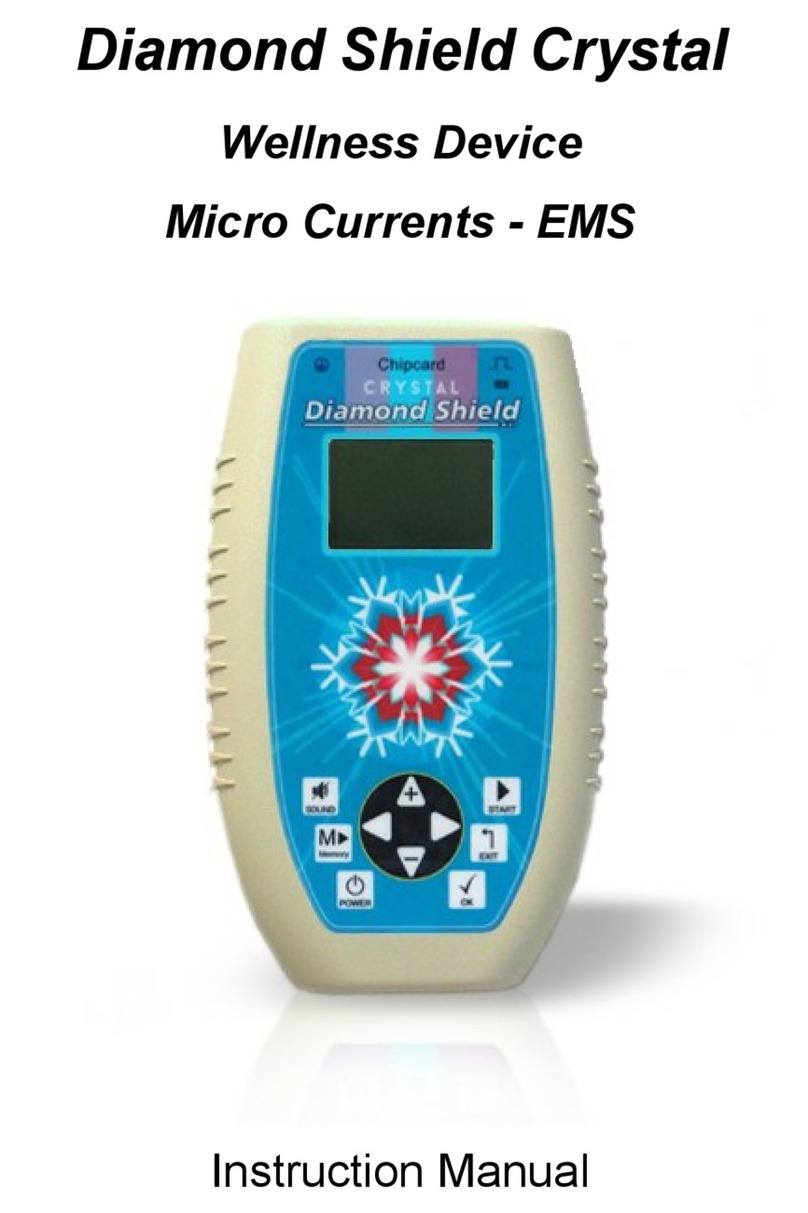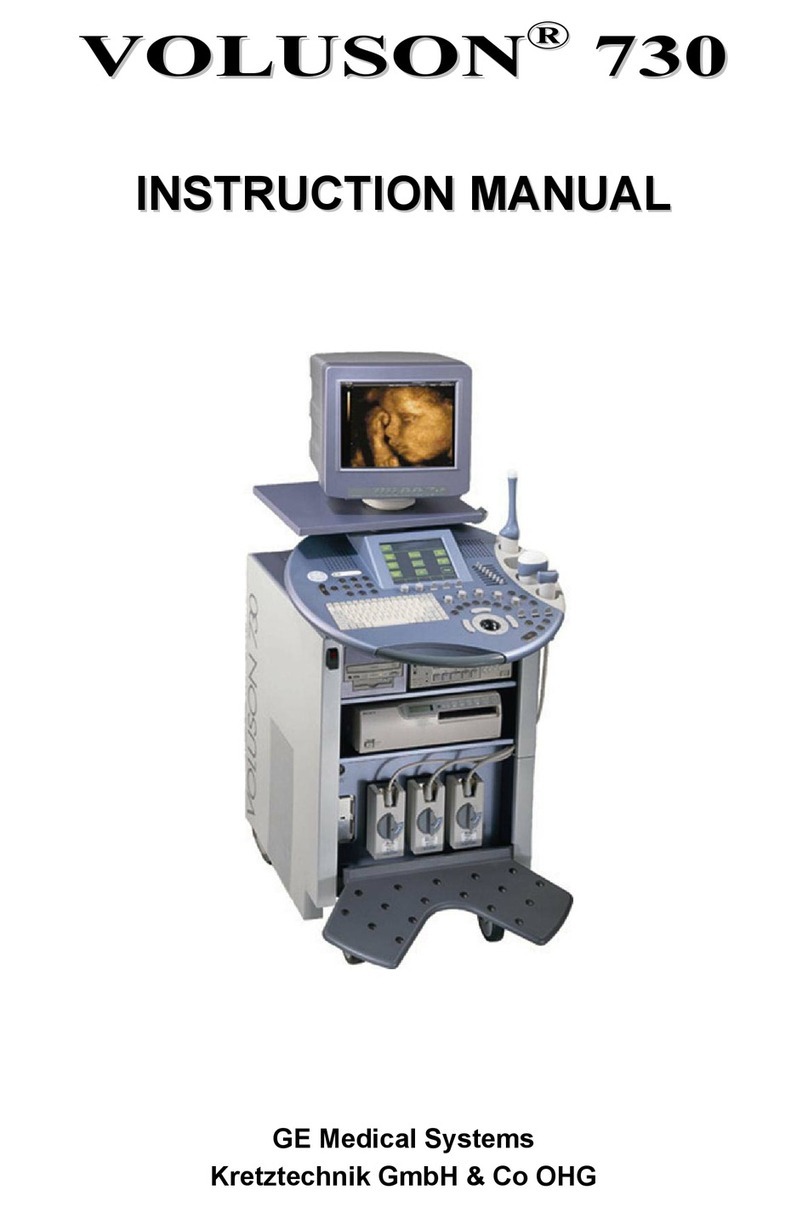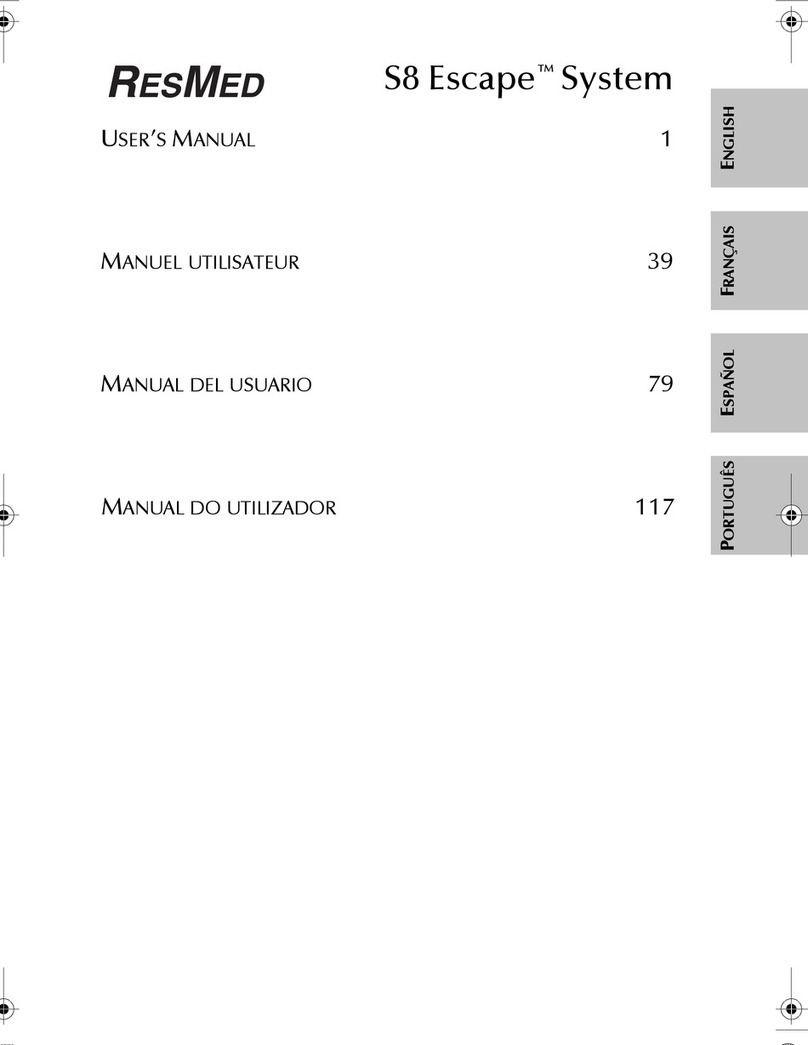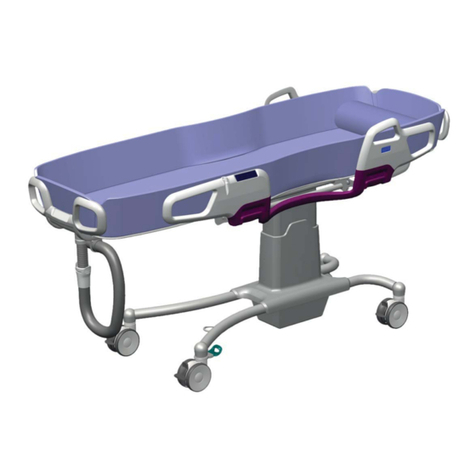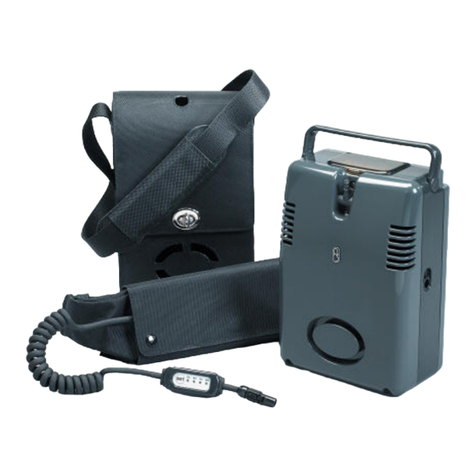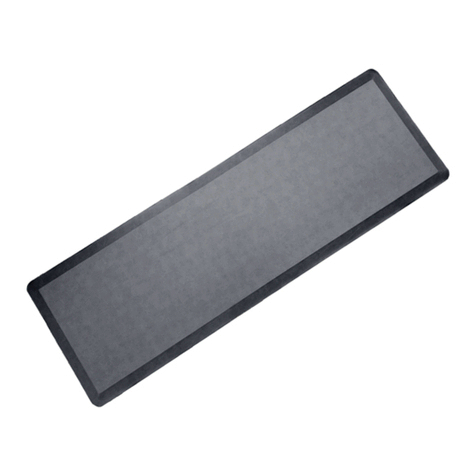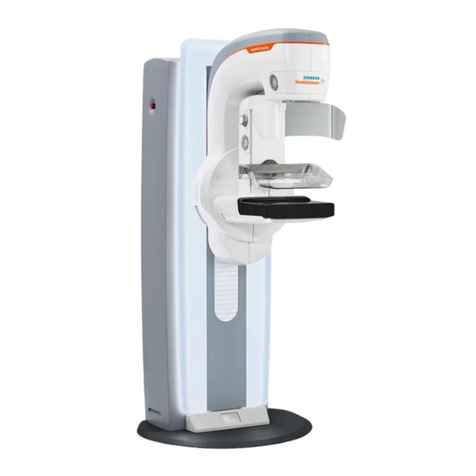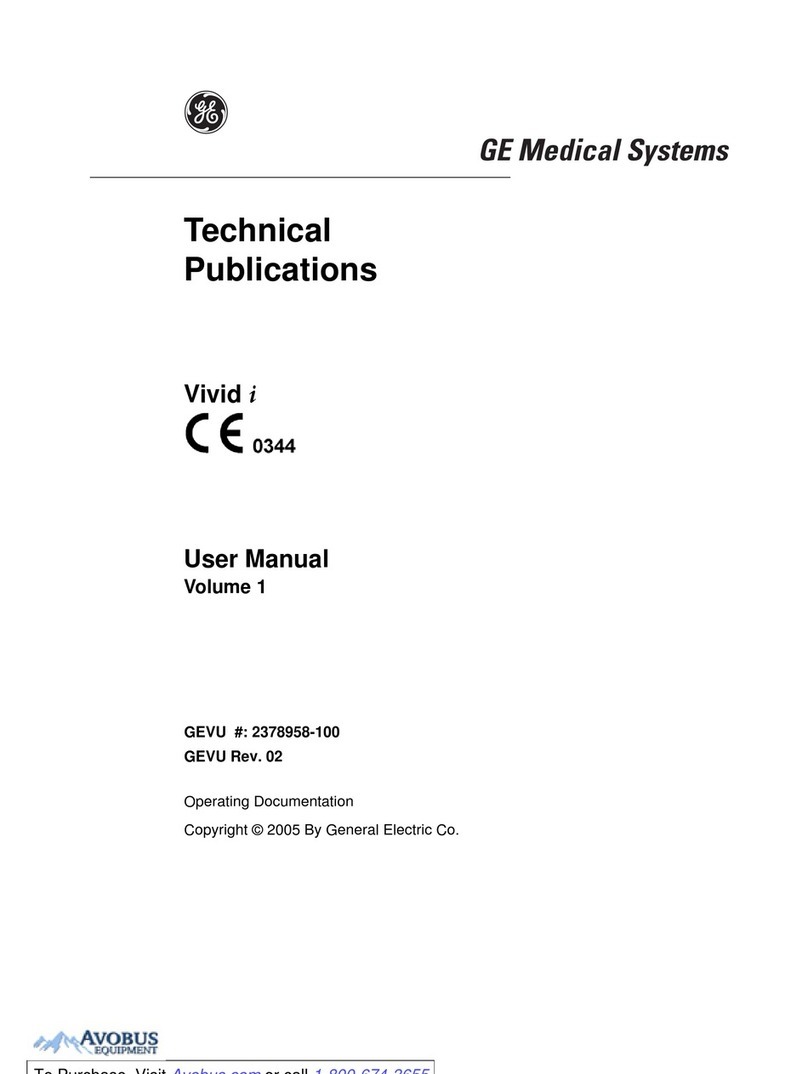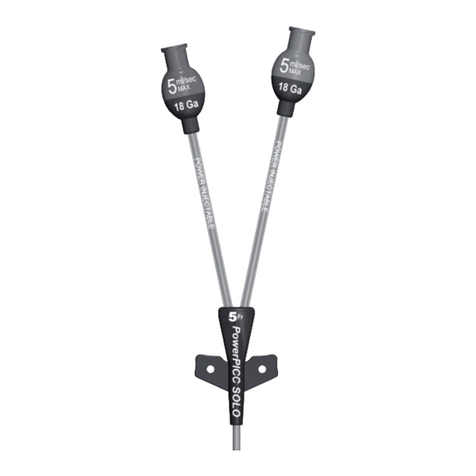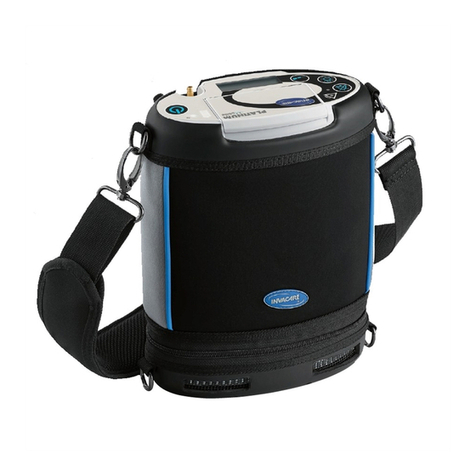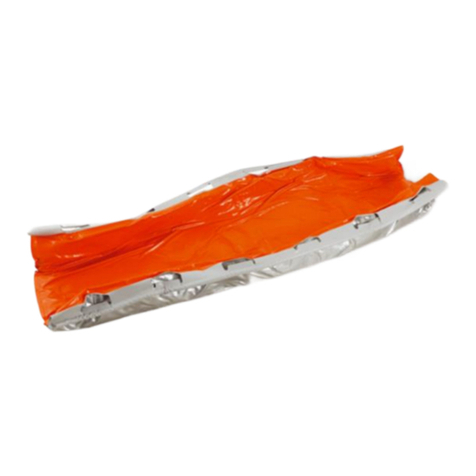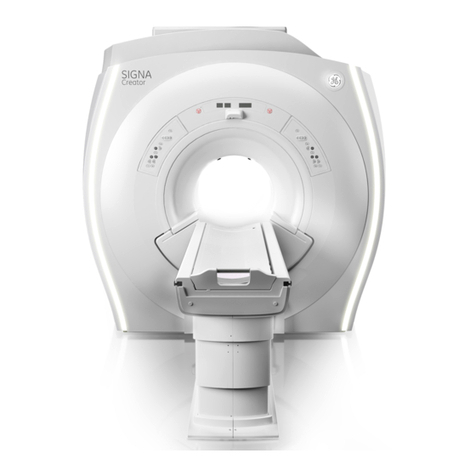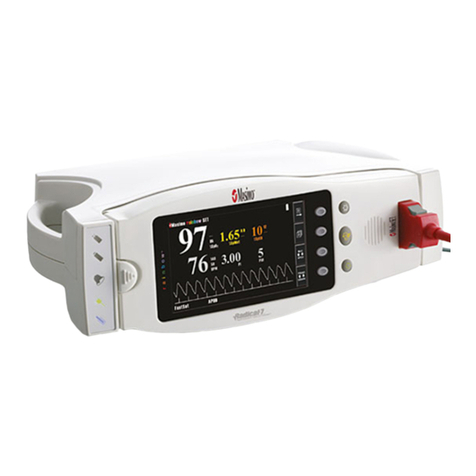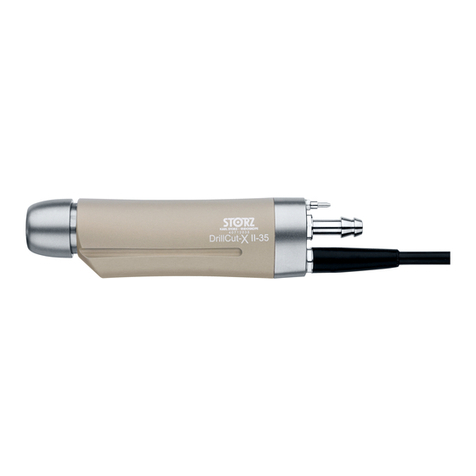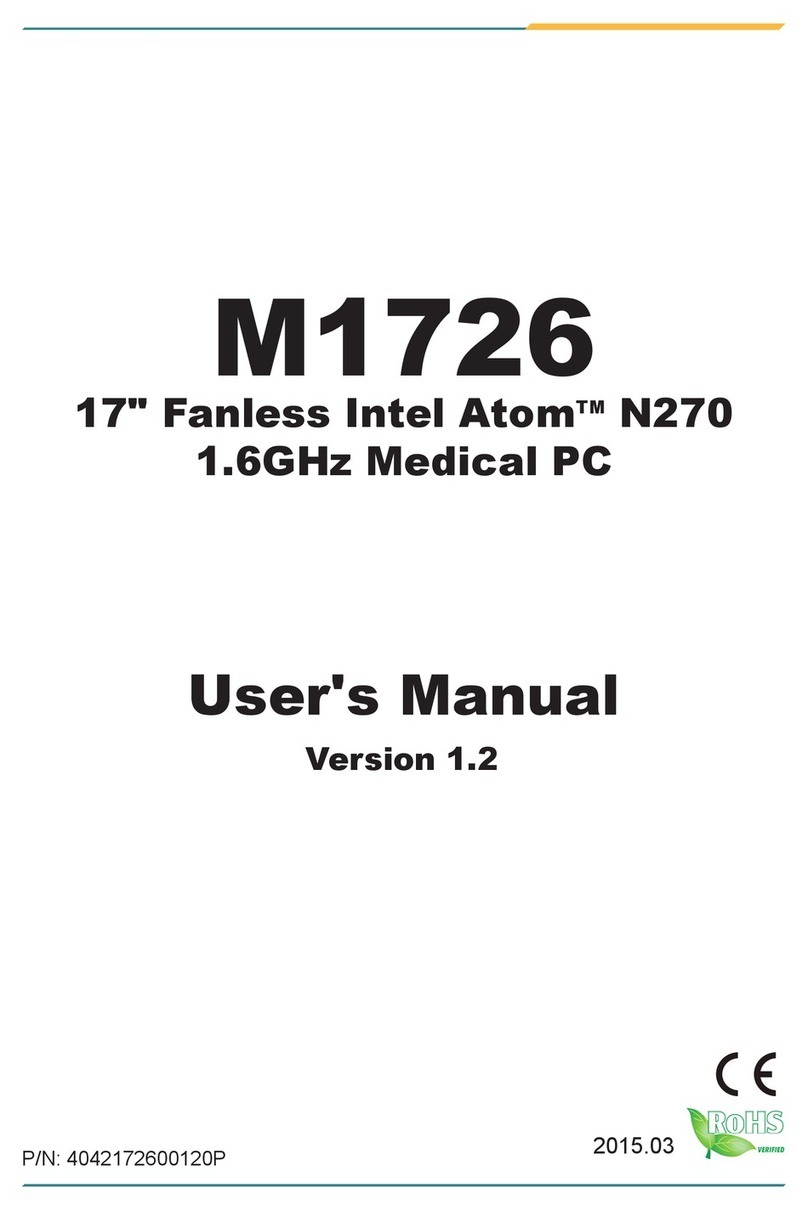Balanced Body Contrology Cadillac User manual

The Contrology® Cadillac
THIS IS A MEDICAL DEVICE
Statement of Intended Use
The Contrology® Cadillac device is intended by the manufacturer to be used by people for the purposes of physiotherapy, rehabilitation, the prevention, treatment
and relief of injuries, supportive, functional therapy for a disability or for general strengthening and improving the mobility of the human body. Should injury occur
during usage please report to the manufacturer and competent authority of the Member State in which the user and/or patient is established.
For printed instructions contact Balanced Body.
Contact Us
1-800-PILATES | +1-916-388-2838
pilates.com | info@pilates.com
17219 A | 2021-11
Balanced Body, Inc
Sacramento, CA
001-916-388-2838
EC
EMERGO EUROPE
Molenstraat 15
2513 BH, The Hague
The Netherlands
REP
Balanced Body, Inc.
5909 88th St,
Sacramento, CA 95828 USA

IMPORTANT:
This manual is intended for medical and fitness professionals, or
persons with experience in the use of this equipment. If there is
a question regarding appropriateness of a particular movement,
please consult a licensed health professional.
Safety Note: Warning – The Cadillac Table contains flammable
materials, please keep away from direct heat.
INTRODUCTION
The Contrology Cadillac consists of a padded table surrounded
by a frame made of metal poles. Eyebolts in the frame provide
attachment points for the springs. Loops, handles or a wooden
Roll-down Bar can be attached to the springs creating a wide
variety of exercises. The Cadillac Table has one moving cross bar
or slider; between the overhead bars which slides horizontal. The
head end of the Cadillac Table holds a hinged wooden frame
called the Push-through Bar (PTB).
Please see the attached diagram for a listing of the various parts
of the Cadillac Table.
FEATURES OF THE
CONTROLOGY CADILLAC TABLE
1. SPRING ATTACHMENT POINTS
Low: Springs are attached from eyebolts in the wood frame at
the PTB end of the table. These springs are used for bottom
sprung exercises using the PTB.
Middle: Springs are attached to the vertical tube eye bolts.
High: Springs are attached to eyebolts in the upper corners of
the canopy.
Overhead: Springs are attached to the horizontal slider between
the overhead bars.
2. CADILLAC TABLE SPRINGS
The Cadillac Table has a wide variety of springs additional heavier
springs can buy purchased for those wanting the same spring
that Joe Pilates used or for more resistance and feedback.
Springs can also have different necking on them to replicate the
original design and manufacturing used by Joe Pilates.
The Springs come in two different lengths - long springs and
short springs. Each length of spring can come in different
resistances either light or heavy. The standard Balanced Body
spring coding is as follows:
Short springs
»Arm Springs – Light
»Arm Springs - Heavy*
»Roll Back Bar Springs – Light
»Push-through Bar Springs – Light
»Trapeze Bar Springs – Very heavy
Long springs
»Leg Springs – Light
»Leg Springs – Heavy** Not included, configured at the time of
the order or purchased separately.
3. SAFETY
It is very important that the instructor is present and spotting
the client whenever the Push-through Bar is in use. The Push-
through Bar should never be used if low enough to hit a client
who is lying under it. The safety chain must always be used. The
safety chain must be adjusted so that the angle of the Push-
through Bar, when viewed from the side, is no lower than either
the four or eight o’clock position.
4. UPHOLSTERY CLEANING AND DISINFECTING.
You can extend the life of your upholstery by keeping it clean
and free of dirt, oil and perspiration. After each use, wipe down
the upholstery with a solution of mild soap and water. Then wipe
it down with clean water and dry with a rag or simply use BB
Cleaner.
2

How to Assemble the Contrology®Cadillac
Belly Strap
Slider
Push
Through
Bar (PTB)
PTB Springs
Trapeze Bar
Sling (not
shown)
Fuzzies
Trapeze Bar
Springs
Large
Kuna
Board
Roll
Back
Bar
Arm
Springs
Foot Strap
Safety
Chains
ƠLeg
Springs
Figure 1: Contrology Cadillac
Roll
Back Bar
Springs
3

PARTS LIST (INCLUDED):
IMPORTANT: To watch a step-by-step video on unboxing and assembling the
Contrology Cadillac, please visit the Contrology Support pages at
Contrology.pilates.com/support
DESCRIPTION PART NUMBER QTY.
Base Frame n/a 1
Cotton Loop (pair) 16992 1
Wool Fuzzy (pair) 16993 1
Roll Back Bar 17111 1
Belly Strap 16996 1
Foot Strap 16994 1
Light Arm Spring ** 17109 2
Light Leg Spring ** 17094 2
Roll Back Bar Spring 16910 2
Push-Through Bar Spring 16912 3
Trapeze Bar Spring 16911 2
Safety Chain, Long 17035 2
Safety Chain, Short 17051 1
Trapeze Bar w/ Sling 17003 1
Trapeze Bar Sleeves n/a 4
Wooden Push Through Bar 17098 1
Kuna Board, Large 16989 1
Leather Handle Assembly (pair) 17115 1
Horizontal Long Tubes Canopy
assembly w/ Slider and corners
n/a 1
Vertical Head End Tube 16965 2
Vertical Foot End Tube 16966 2
Screws 1/4”-20 x 5/8” Long 15223 8
Eye Bolt, 1/4-20 x 2” 13657 2
Finish Washer, #12 10522 2
3/16” Allen Wrench 13777 1
5/32” Allen wrench 13778 1
Leveling Foam Foot Pad 17195 4
Tubing for Footstrap Clip 17482 2
**These may be changed out for heavy Springs; Arm: 16937,
Leg: 16908
ASSEMBLE THE TRAPEZE CANOPY
1. Note this frame is very heavy. It is recommended to have a
minimum of (2) people to lift and move the base frame.
2. Unbox the base frame and move it to the desired location. Unbox all
components from the canopy box and match them to the Parts list
ensuring you have all the components before beginning.
3. Find the provided Eye Bolts and Finish Washer and install in
the legs as shown, one on each Foot End Leg. Tighten the eye
bolts by turning clockwise. Once the bolts start to get tight,
continue to spin them and orientate them so they are vertical.
See Figure 2.
4. Remove the two vertical head end tubes from the box with the
Push-through Bar system. When picking up this assembled
tube set, be careful of the PTB, it may swing. On one side of the
vertical tubes, on the lower half, there will be two screws installed
in threaded holes. Remove these screws, these holes line up
with holes in legs. Place the tubes into the frame leg extrusion
openings opposite the legs you just installed the eye bolts in.
See Figure 1.
5. Insert the tubes all the way to the bottom of the legs. Once
installed the holes in the tubes will line up with the holes in
the legs, if necessary lift the tubes just slightly to align. Use
the provided 5/32” Allen wrench and 1/4”-20 x 5/8” screws to
lock the tubes into position.
6. Install the foot end vertical tubes into the other two leg
openings. Ensure that the upper eye bolts are facing away
from the upholstery mat. Tighten using the 5/32” Allen
wrench and 1/4”-20 x 5/8” screws. See Figure 1.
7. Now set the canopy top onto the four vertical tubes. You will
need help with this. The end of the canopy frame with the (3)
eye bolts goes over the Push-through Bar. Be certain all four
corner fittings fit securely over the tubes. See Figure 1.
8. Using the 3/16” Allen wrench, tighten the set screws in all
four corner fittings and in the flanges around the frame.
After tightening all set screws in all the corner fittings, test
the movement of the Trapeze Bar slider. To do this, ensure
the knobs on the outside are loose, push the Bar assembly
horizontally. This system should move easily and not stick
when uniform pressure is applied. Run the Trapeze Bar
assembly the entire length of canopy. If the slider sticks when
moving the position, simply loosen the set screws that are
holding the horizontal tubes, rotate the tubes as necessary
until the sliders move freely. Be sure to re-tighten all set
screws when complete.
9. Attach the Arm, Leg, Roll Back Bar, Push-through Bar and
Trapeze Bar springs to their appropriate locations. See Figure 1 for
locations of springs. See Figure 3, 4 for pictures of springs.
10. Attach the Roll Back Bar to the Roll Back Bar Springs.
Figure 2: Eye Bolts and Finish Washer
4

11. Install the Trapeze bar Bar Springs to the Slider outside eye
bolts. The hooks of the springs should go on eye bolts and
dog clip attaches the Trapeze Bar Pad. Lastly attach the
Trapeze Bar Sling to the Trapeze Bar. See Figure 1.
12. Attaching the Push Through Bar Springs to the frame. The
spring with the (1) quick link is to be installed on the canopy
eye bolt for the Push through Bar. The (2) springs with the
Spring covers attach on the bottom frame eye bolts using
the long open hooks. See Figure 1. All dog clips will attach the
spring to the Push Through Bar.
13. Attach the Long Safety Chains to the outside eye bolts on the
top canopy head end. See Figure 1. Attach the short Safety
Chain to the middle eye bolt on the same end. The quick links
will be attached to the eye bolts in the canopy, see Figure 5.
14. Attach the loops to the end of the leg springs.
15. Attach handles to the arm springs.
16. Attach foot strap to foot end eye bolts on the frame. The
footstrap will have tubing over the clips. To install, slide the
tubing down to access the lever. Once installed move the
tubing back over the clip to prevent damaging the pad. To
see a video on this process, please visit the Support section at
Contrology.pilates.com. See Figure 1.
17. Install the Belly Strap over and around the upholstery pad.
18. If desired place the Large Kuna board up against the foot end
vertical tubes.
19. Provided leveling pads can be placed under the legs of your
device if needed. Use as needed.
TOY BOX VERSION
The base frame may have a factory installed hidden “Toy Box”.
If your Base Frame has this feature, once the machine is in the
desired location and setup with the canopy, look under your top
frame rails to locate a plastic zip tie on the underside of your
Toybox. Using scissors or blade, cut this zip tie. This is installed
for shipping, and with it removed allows the lid to open.
Be sure to loosen the Belly Strap fully before trying to open the
lid or ensure it is not attached.
Make sure the PTB is out of the way or raise it up to the high
position and secure with the safety chain. Reposition or remove
any accessories or springs that may be in the way of the opening
Toy Box top.
There are (2) subtle recessed handles in the vinyl, on one side,
used for hand access points. Places your fingers into these
openings and lift the upholstery lid up. There are (2) gas shocks
that assist the lid up at a controlled speed. It will stop opening
on its own. This compartment can be used to store extra
loops, handles, springs, Kuna board, airplane board and other
accessories.
To close, make sure others are free and clear before closing,
push the lid down it will take a little force to get it started. Once
the lid is about 3” from the frame it will close on its own. Make
sure all fingers and clear when closing. Re-tighten the Belly Strap
as desired.
HOW TO ADJUST YOUR SLIDING TRAPEZE BAR
Position your hands on the outside of each slider. Place your
thumb and fore and/or middle fingers over the knobs; spin them
clockwise to lock threads into the tubes. This locks the Trapeze
Bar assembly into position so it does not slide. It is recommended
to always lock BOTH knobs for safety purposes. Spin the knobs
Figure 3: A) Leg Springs (the longest springs)
B) Roll Back Bar Springs (have 2 dog clips attached)
C) Arm Springs (only 1 dog clip attached)
A)
B)
C)
Figure 4: D) Trapeze Bar Spring
E) Push-through Bar Springs
E)
D)
Figure 5
5

the opposite direction to loosen and move the assembly. Once
you are in the desired location tighten the knobs.
WEEKLY MAINTENANCE
Inspect springs for separations, and replace if needed. Inspect
snaps on springs and make sure the retractors operate smoothly.
Replace them if worn or do not operate freely. Make sure that
there are no indentations on the inside of the hooks.
Inspect all nuts, eyebolts and setscrews for tightness. Tighten or
replace if necessary.
QUESTIONS?
Call Balanced Body at 1-800-PILATES (1-800-745-2837) or
+1 916-388-2828.
6

How to Install your Wire Stops on your
Contrology Springs
PARTS INCLUDED:
DESCRIPTION PART NO. QTY
Wire Stop 17922 7
10-24 Set Screw 17931 7
3/32” Allen Wrench 17930 1
Start to thread a provided set screw into each wire stop, install the
set screw into the wire stop so about 1/4 of the set screw sticks out.
(Note they might be already in the wire stops, if they are, ensure
they are not going into the middle opening of the wire stop)
Go to the top mounted spring attached to your machine, See
Figure 6. Install a wire stop onto the end of the open hook. Slide
the middle opening of the wire stop onto the wire so that the wire
end is barley coming out the underside of the wire stop.
Make sure the wire stop length of the body is perpendicular to
the wire, See Figure 7. Use the provided Allen wrench to tighten
the set screw. Ensure the set screw is very tight to prevent them
from coming loose.
Repeat the above steps for the other springs with open ends.
There are (3) Push through bar springs, each getting one on the
frame end of the spring and (2) trap bar springs each getting 2
wire stops, one on each end.
Figure 6
Figure 7
7

Contact Us
1-800-PILATES | +1-916-388-2838
pilates.com | info@pilates.com
215-000 | 11.12.21
Safety First:A guide to proper maintenance
and safe use of your Pilates equipment.
For over 35 years, Balanced Body has been introducing
safety-related innovations to Pilates equipment. Many of our
improvements are now industry standards, resulting in Pilates
equipment that’s safer today than ever before.
Safety depends on proper maintenance and safe use, in addition
to the quality of the equipment. This guide was created to help
you use and maintain your equipment for optimum safety. Please
read it through carefully and keep for future reference. If you have
any questions, give us a call. Failure to follow these instructions
may result in serious injury.
ALL EQUIPMENT
Springs
Spring inspections are critical to maintain your equipment in
safe operating condition. All Balanced Body springs should be
replaced at least every two years. Certain environments and
usages can shorten the expected life of the springs and you may
need to replace the springs more frequently. Therefore, it is very
important to inspect springs on a regular basis since worn or
old springs lose resilience and may break during use. Injury may
result if a spring breaks during use.
During use, do not allow springs to recoil in an uncontrolled
manner. This will damage the spring and shorten its expected life.
Inspect springs for gaps and kinks (weekly or monthly,
depending on frequency of use). Look for gaps and kinks
between the coils when the spring is at rest. It is not unusual
for the spring to have a very small gap on the tapered end (a
gap is sometimes created during the manufacturing process).
However, there should be no gaps in the body of the spring. If you
see any gaps or kinks in the body of the spring, discontinue use
and replace the springs immediately. See Figure 1. Additionally,
corrosion anywhere on the coils will shorten the life of the spring.
Discontinue using the spring immediately if you see any rust or
oxidation during inspection.
Kink
Figure 1
Snaps
Inspect snaps for wear (monthly). First, verify that the snap hook
is working properly. If the snap hook does not retract and return
properly, discontinue using the spring immediately and replace
the snap. Eyebolts can cause excessive wear on snap hooks.
If the hook shows a lot of wear, discontinue using the spring
immediately and call Balanced Body to replace spring or snap.
See Figure 2.
Figure 2: Good snap: no wear on hook. Bad snap: excessive wear on hook.
EYEBOLTS, NUTS AND BOLTS
Tighten all equipment bolts and screws (monthly). Verify that all
eyebolts, nuts and bolts are tight. See the section titled “How to
inspect and tighten nuts and bolts.”
ROPES AND STRAPS
Rope and strap wear (quarterly). Ropes should be replaced if you
can see the core of the rope through the outer lining, or if the
ropes are flattened. Straps should be replaced as soon as any
fraying is noticed. Be sure to check the sections of rope or straps
that attach to the clips and run through the pulleys.
REFORMERS
Check springbar hooks or eyebolts (quarterly). Balanced Body
makes two different springbar systems:
»Revo Springbar. Make sure springbar hooks and handle
are tight.
Standard Springbar. Verify that the nuts securing the springbar
hooks are tight. See section titled “How to inspect and tighten
nuts and bolts.”
8

2
Spring rotation (quarterly).You can prolong Reformer spring life
by rotating springs of the same weight each quarter. Unhook and
move to another position on the springbar. Rotating springs helps
them wear more evenly.
Risers on the outside. Wood risers must be installed on the
outside of the frame. Risers can loosen over time, so always
make sure they are tight.
Springs hooked downward under carriage. Make sure springs are
hooked in a downward
position. See Figure 3.
Secure the carriage. When your
Reformer is not in use, be sure
that at least two springs secure
the carriage to the springbar.
Default settings. Many users have a “default setting” for
Reformers. At the end of a session, the user connects a
prescribed number of springs in neutral tension, sets the footbar
at a pre-determined height, and sets the ropes at a specified
length. This ensures that the equipment is ready for the next use,
and that the carriage is secured by the springs.
Footstrap under tension in box
work. When using the box and
footstrap, be sure the footstrap
is under tension (with snaps
pulling from the top of the
eyebolt) before beginning the
exercise. See Figure 4.
REFORMER WHEEL AND TRACK MAINTENANCE
Clean the tracks and wheels (weekly). For smooth carriage travel
and to maintain the longevity of the wheels, we recommend that
you wipe down the tracks once a week.
Disconnect the springs and clean the entire length of the tracks
with a soft cloth and Balanced Body Cleaner, mild soap with
water or a mild commercial cleaner such as, Fantastik® or 409®.
Do not use abrasive cleansers or pads, as they can damage the
anodizing on the rails. To clean the wheels, hold the cloth against
the wheels while you move the carriage. If you feel a bump in
the ride, dirt has adhered to the surface of the rails or wheels.
Clean hair and debris out of the rails. Hair can wrap around the
wheel axles and eventually build up and cause wheel failure. Use
tweezers to remove hair from the wheels.
Lubrication. Never spray silicone near or inside the wheels – this
can wash the lubricant out of the bearings and ruin the bearings.
You can purchase dry silicone at most hardware and auto parts
stores. Pulleys sometimes require lubrication to stop a squeak.
Direct a very quick spray of dry silicone or Teflon spray into the
pulley. “Dry” silicone does not have an oil base. Oil-based (“wet”)
silicone and WD40 should not be used as they attract dirt. Be
careful not to over spray. You may want to remove ropes to avoid
getting silicone on them.
Do not lubricate the Allegro 2 rails.
Footbar supports (quarterly). For all Balanced Body footbars with
footbar support brackets, verify that the pivot screw attaching the
footbar support bracket to footbar is tight, but not so tight that it
prevents the support from rotating freely. For Legacy Reformers,
tighten the pivot bolt to secure footbar support.
Headrest (monthly). Make sure the hinge screws and bolts on
your headrest are tight.
Under the Reformer (monthly). Move Reformers and make sure
you clean the floor space underneath.
Standing Platform Footbar Bumpers (wood Reformers only). If
your standing platform footbar bumpers (the small plastic pieces
that protect the standing platform from the footbar) are broken
or damaged, please call Balanced Body to replace.
TRAPEZE TABLE (CADILLAC) & TOWERS
Cotter pins removed. These
pins are located in the vertical
tubes that align the canopy
to the frame and should be
removed as soon as installation
is complete. Unremoved cotter
pins can tear clothing and
lacerate the skin. Use pliers to
remove the pins.
Save the pins in case you need to disassemble and reassemble
the table for transportation purposes. See Figure 5.
Push-Through Bar (PTB) with Sliders.
The PTB moves vertically to accommodate different users
and exercises. The sliders on the tubes allow for this vertical
movement. Make sure these sliders are clean and easy to move.
Before beginning any exercise, ensure that the sliders are properly
aligned with the PTB holes and locked into position. Apply a
downward force to ensure. If you notice wear on the slider knob
pins, please call Balanced Body to replace. Using the PTB in this
condition could cause injury.
Weekly maintentance for Push-Through Bars with Sliders. Check
to ensure the pins in the plunger knobs protrude and lock into
the vertical tubes. Pull both knobs out and move the sliders to
a different position. Release the knobs before the next hole and
continue to slide the system into position. Once over a hole the
pin of the knob will automatically drop into the opening. Once
each slider is in a new position apply a downward force on the
PTB. The pins of the sliders should not come out of the holes. If
the pins do not stay in the tube holes, the pull knobs need to be
replaced. Call Balanced Body for replacement parts.
Push-Through Bar (PTB) with T-pin setting.For bottom sprung
exercises, if your client’s head is below the PTB, use the T-pin setting
in addition to the safety strap or chain. Spotting your client is highly
recommended. This is important for safety.
Push-Through Bar (PTB) control. Make sure you have enough
room around the trap table to safely use the PTB without fear of
hitting other people. The PTB can be dangerous if not properly
Figure 3: Springs hooked downward
Figure 4: Foot strap under tension
Figure 5: Cotter pin before and after
removal from Trap Table.
Contact Us
1-800-PILATES | +1-916-388-2838
pilates.com | info@pilates.com
215-000 | 11.12.21
Safety First:A guide to proper maintenance
and safe use of your Pilates equipment.
For over 35 years, Balanced Body has been introducing
safety-related innovations to Pilates equipment. Many of our
improvements are now industry standards, resulting in Pilates
equipment that’s safer today than ever before.
Safety depends on proper maintenance and safe use, in addition
to the quality of the equipment. This guide was created to help
you use and maintain your equipment for optimum safety. Please
read it through carefully and keep for future reference. If you have
any questions, give us a call. Failure to follow these instructions
may result in serious injury.
ALL EQUIPMENT
Springs
Spring inspections are critical to maintain your equipment in
safe operating condition. All Balanced Body springs should be
replaced at least every two years. Certain environments and
usages can shorten the expected life of the springs and you may
need to replace the springs more frequently. Therefore, it is very
important to inspect springs on a regular basis since worn or
old springs lose resilience and may break during use. Injury may
result if a spring breaks during use.
During use, do not allow springs to recoil in an uncontrolled
manner. This will damage the spring and shorten its expected life.
Inspect springs for gaps and kinks (weekly or monthly,
depending on frequency of use). Look for gaps and kinks
between the coils when the spring is at rest. It is not unusual
for the spring to have a very small gap on the tapered end (a
gap is sometimes created during the manufacturing process).
However, there should be no gaps in the body of the spring. If you
see any gaps or kinks in the body of the spring, discontinue use
and replace the springs immediately. See Figure 1. Additionally,
corrosion anywhere on the coils will shorten the life of the spring.
Discontinue using the spring immediately if you see any rust or
oxidation during inspection.
Kink
Figure 1
Snaps
Inspect snaps for wear (monthly). First, verify that the snap hook
is working properly. If the snap hook does not retract and return
properly, discontinue using the spring immediately and replace
the snap. Eyebolts can cause excessive wear on snap hooks.
If the hook shows a lot of wear, discontinue using the spring
immediately and call Balanced Body to replace spring or snap.
See Figure 2.
Figure 2: Good snap: no wear on hook. Bad snap: excessive wear on hook.
EYEBOLTS, NUTS AND BOLTS
Tighten all equipment bolts and screws (monthly). Verify that all
eyebolts, nuts and bolts are tight. See the section titled “How to
inspect and tighten nuts and bolts.”
ROPES AND STRAPS
Rope and strap wear (quarterly). Ropes should be replaced if you
can see the core of the rope through the outer lining, or if the
ropes are flattened. Straps should be replaced as soon as any
fraying is noticed. Be sure to check the sections of rope or straps
that attach to the clips and run through the pulleys.
REFORMERS
Check springbar hooks or eyebolts (quarterly). Balanced Body
makes two different springbar systems:
»Revo Springbar. Make sure springbar hooks and handle
are tight.
Standard Springbar. Verify that the nuts securing the springbar
hooks are tight. See section titled “How to inspect and tighten
nuts and bolts.”
9

3
used. Only trained, experienced users should use the PTB. A
spotter should always maintain control of the bar with one hand.
If the user should lose control of the bar, the spotter can maintain
control of it.
Correct safety strap attachment. For bottom-sprung exercises,
the safety strap or chain should always secure the bar.
The safety strap or chain
should wrap around the PTB
and the canopy frame, not the
eyebolts. The strap or chain is
only as strong as the weakest
link, and the frame and bar
are a great deal stronger than
eyebolts. Figure 6.
Spotting your client is highly
recommended. This is
important for safety.
Setting the PTB for bottom-sprung exercises. For bottom-
sprung exercises, the safety strap should be attached so that
the angle of the push-through bar is no lower than the 4 o’clock
position. This limits the range of the bar and prevents it from
potentially coming into contact with the user.
Using the 4th side on the PTB
along with the safety strap is
highly recommended to prevent
injury.
CHAIRS
Dismount with control. When
dismounting the chair, release
the pedals slowly, with control.
Don’t let the pedal snap back.
Spot users. When a user is
standing, sitting or lying on top of the chair, there is increased
risk of falling. Standing exercises, in particular, can be unstable.
Spotting users will make these exercises safer.
Hourglass spring mounts. If your chair has hourglass spring
mounts and the mounts do not successfully retain the springs,
replace the fiber washers (they are reddish-brown in color).
Figure 8. If your chair is a Balanced Body
Split-step Pedal Chair (Combo Chair),
please consider upgrading to the Cactus
Springtree).
UPHOLSTERY CLEANING & MAINTENANCE
Cleaning. You can extend the life of upholstery by keeping it
clean and free of dirt, oil and perspiration. After each use, wipe
down the upholstery with a solution of mild soap and water. Then
wipe it down with clean water and dry with a soft towel.
Disinfecting. Equipment upholstery is coated with BeautyGard®,
which offers antibacterial protection. If you want additional
disinfection, Balanced Body offers Balanced Body CleanTM
disinfecting solution. Use of any other solution (especially those
containing essential oils) will shorten the life of some equipment
and is not recommended.
HOW TO INSPECT AND TIGHTEN NUTS AND BOLTS.
Use your fingers to check nuts and bolts
for tightness. If you can turn the nut or
bolt with your fingers, it’s too loose and
should be tightened. To tighten, first
tighten using your fingers. Rotate nuts
and bolts clockwise to tighten. Insert a
screwdriver through eyebolts to hold them
steady while you tighten the nuts. Then
use a small wrench to tighten the nuts
further. Figure 9.
It is recommended to check the pins on the PTB protrude
and lock into the vertical tubes appropriately. To verify their
function, first pull both knobs out and start moving the sliders
to a different position. Release the knobs before the next hole
and continue to slide the system. Once over a hole the pin of
the knob will drop into the opening. Once each slider is in a new
position apply a down force on the PTB directly downwards. The
pins of the sliders should not come out of the holes. If the pins
do not stay in the tube holes, the pull knobs need to be replaced;
call Balanced Body for replacement parts.
Figure 6: Safety strap holding the
push-through bar at 4 o’clock. The strap is
secured to the PTB and canopy frame, not
the eyebolts.
Figure 9: Use two fingers to
tighten bolts
Figure 7: Safety strap holding the
push-through bar at 4 o’clock. The strap is
secured to the PTB and canopy frame, not
the eyebolts.
Figure 8: Fiber washer
10

Contact Us
1-800-PILATES | +1-916-388-2838
pilates.com | info@pilates.com
215-000 | 11.12.21
EQUIPMENT INSPECTION AND MAINTENANCE LOG
We suggest that you keep a maintenance log for each piece of
equipment. The log should include:
1. A description of the machine including the serial number, the
date and place of purchase, and the manufacturer. All of this
information should appear on the invoice.
2. Date and description of all required maintenance and
inspections performed.
Date and description of each repair, including name and
contact information for person or company performing
the repair.
MAINTENANCE SCHEDULE
All Equipment Day Wk. Mo. Qtr.
Inspect springs for gaps & kinks
Inspect snaps for wear
Inspect nuts & bolts for tightness
Reformers
Clean wheels and tracks
Inspect springbar hooks/eyebolts
Rotate springs
Inspect ropes/straps
Inspect footbar supports
Inspect One-Step springbars
REPLACEMENT PARTS
To order replacement parts, or if you have any questions,
please call:
U.S. and Canada: 1-800-PILATES (1-800-745-2837)
United Kingdom: 0800 014 8207
Other locations: +1 916-388-2838
Fax: 916-379-9277
www.pilates.com
5909 88th Street, Sacramento, CA 95828 USA
ASSEMBLY AND MAINTENANCE PODCASTS
View our library of assembly and maintenance videos at
www.pilates.com\podcasts.
Click here for Balanced Body Patent Data.
11

SAFETY & MAINTENANCE
SAFETY
To reduce the risk of injury or damage, read all instructions and
the following important precautions before using the Contrology
Cadillac.
»It is the responsibility of the owner to ensure that all users
of the Contrology Cadillac are adequately informed of all
precautions.
»Use the Contrology Cadillac only on a level surface.
»Keep hands and feet away from all moving parts. When the
Contrology Cadillac is not in use, leave at least two springs
connected to the frame.
»Keep children under the age of 12 and pets away from the
Contrology Cadillac at all times.
»If you feel pain, dizziness, or shortness of breath, stop
exercising immediately.
»Do not stand on the footbar.
»Before beginning any exercise program, consult your
physician.
»Do not stand the Contrology Cadillac on end without the wheel
kit.
MAINTENANCE
»Depending on frequency of use, the springs should be safe to
use for one to two years (3000 hours). Replace any spring that
is kinked, bent or shows separations while at rest.
»If your ropes need to be replaced refer to the instructions on
the underside of the carriage. The Reformer will need to be
turned on its side (please place a Pilates mat on the floor next
to the Reformer to protect the finish), or stood on end if you
have transport wheels.
»Remove hair and debris from the axles of the wheels. Debris
can create pressure on the wheels, causing them to wear. If
you hear noise from the bearings, replace them.
»Repair any tears in the upholstery with an upholstery repair kit
available at auto parts stores, or have the repair done locally.
»Contact Balanced Body for other upholstery and re-upholstery
options. Replacement upholstery is available from Balanced
Body.
»Check and tighten all screws and bolts. Replace any missing
screws, retention pins, or other parts.
»Check the footbar bolts on a monthly basis to make sure they
are still secure.
CLEANING
Wipe the carriage pad, headrest, footbar and shoulder rests with
a soft cloth and a mild, non-abrasive mixture of soap and water
after each use. Keep the carriage track and wheels free from
dust and dirt. Clean the frame with a mild, non-abrasive mixture
of soap and water. Keep the ropes and springs clear of dust.
Cotton loops can be machine-washed. Hang to dry.
NOTE: DO NOT LUBRICATE OR GREASE ANY COMPONENTS
ON THE FOOTBAR, CARRIAGE, WHEELS OR RAILS. If you have
any issues or questions please contact Balanced Body Techincal
Support. By adding lubrication or grease it may not lock the
components securely and may become unsafe.
Questions? Call Balanced Body Technical Support at
1-800-PILATES or +1-916-388-2838 or info@pilates.com.
12

Classical Pilates Studio Best Practices and Safety Guidelines
General Studio Safety
1. Keep pathways clear of equipment and accessories.
2. Inspect all apparatus and maintain equipment on regular.
weekly/monthly/quarterly basis. See manufacturers guidelines.
3. Reset, check and clean all equipment after use
Contrology Cadillac
1. Cadillac reset
a. Rollback bar hooked to top hooks.
b. Leg springs placed on appropriate hooks.
c. Arm springs stored either on outside hooks or on inside
hooks by the Push-through bar (PTB).
d. PTB is stored in the upright position and secured with the
storage chain, or per studio’s specifications.
e. Trapeze is either stored in the toy box, under the Cadillac or
on the hooks.
f. Safety chains are hooked to the top eyelets.
g. Store all accessories (ie. neck stretcher, airplane board,
additional springs under the Cadillac).
2. Recommended monthly safety check
a. Inspect all springs for signs of wear (kinks, rust and
uneven separations when the spring is opened). Replace
immediately if there’s an issue. Refer to Figure A at the end
of this document
b. Inspect all clips (snaps) for signs of wear - check the snaps,
eyelets, openings and clips. Replace immediately if there’s
an issue. NOTE: If you dropped the spring, could it fall on
the client? Refer to Figure C at the end of this document.
c. Check the stitching on all the straps and loops for wear and
loose stitching and replace immediately.
d. Check the fuzzies and the underlying loops for loose stitching
and worn material. Replace immediately if signs of wear.
e. Inspect the PTB pivot points.
f. Check and tighten all eyelets (aka eyebolts or hooks) as needed.
Note: If you can twist an eyebolt by hand, it is too loose.
g. Check the screws on the poles and canopy and tighten if
necessary.
h. Check the PTB safety chains, and eyelets for signs of wear.
i. Inspect all connection points for sense of wear.
3. During a session
a. If you need to take springs off during a session, store them
under the Cadillac or in the toy box.
b. Make sure the clips / snaps are seated properly.
c. Double check clips on the PTB and that the safety chains
are connected properly.
d. It is critical keep control of the Push-through whenever
working with clients. Always use extreme caution.
e. Set and check the QuickLinks and wire stops on the springs
are fastened and seated correctly. Refer to Figure B and D at
end of this document.
f. Verify that all Cadillac springs with open hooks have wire
stops attached.
For additional info on the “set and check” procedure for optimal
safety, check out this video.
13

NOTE: This is not a Contrology spring but kink will look similar
QuickLink not fastened. (first pic) QuickLink fastened. (second pic)
Bad snap: excessive wear on hook. (not a Contrology snap but
wear will look similar).
Wire Stops
Figure B
Figure C
Figure A
Kink
14

Exercises for the Contrology®Cadillac
THE LEG SERIES - LEG CIRCLES
Set-Up: Leg springs with loops, hooked from the rollback
bar side
Repetitions: 5 each direction
Goals:
»Coordinate lower body movement with torso stability
»Strengthen the legs
Precautions
»Knee injuries
»Some shoulder injuries – place the arms by the side to
accommodate.
Prerequisites
»Mat - Single Leg Circle
»Reformer - Frogs / Leg Circles
Starting Position
»Place the feet in the loops of the straps and bend the knees
into the chest in the frog position - Heels together, toes apart
and the knees approximately shoulder width.
»Bring the arms over the head on to the polls- thumbs and
fingers together. The arms should be high enough so that
back can stay flat on the mat.
»Press into the poles to bring the shoulders down and connect
into the back.
Instructions
»Starting in the frog position, press the legs out straight. The
pelvis should remain flat on the mat.
»Open the legs to the width of the Cadillac
»Press down towards the mat without letting the back arch
»Bring the legs together and back to the starting position
»Repeat five times and reverse
15

THE ARM SERIES – TRICEP PRESS
Set-Up: Arm springs with handles hooked to the push-
through bar side.
Repetitions: 5
Goals:
»Connect the upper body to the center
»Strengthen the back of the arms
»Work symmetrically
Precautions:
»Some wrist injuries
»Some shoulder injuries
Prerequisites:
»Mat and reformer foundations
Starting Position:
»Lie on your back with your head towards the push through bar
poles, knees bent and hip-width apart. * Note distance from
the poles will be determined by the student’s strength.
»Place your hands in the handles, palms facing down and arms
at shoulder height.
»Press the upper arm and elbow towards the mat.
Instructions:
»With the shoulders connected to the back, and the upper arm
glued to the mat, press the forearm arms down towards the
waist and hold for a count of five.
»Bring the spring back to the starting position with control
16

PUSH THROUGH
Set-Up: 1 spring from the top attached to the push-
through bar
Repetitions: 3
Goals:
»Spinal flexibility
»Hamstring flexibility
»Scapular mobility and stability
Precautions
»Some shoulder injuries
»Some back injuries
Prerequisites
»Mat - Roll-Up
»Mat - Spine Stretch Forward
Starting Position
»Sit facing the Push through bar.
»Legs are long and feet are flexed against the poles.
»Place the hands on the bar with straight arms and a tall back.
Instructions
»Starting from the center pull away from the bar, moving into a
round back position.
»When the bar and the arms are in alignment, press the bar
down, lift the ribs up and over and stretch forward.
»Pull the center back into the round back position with control.
»When the bar and the arms are in line, press the bar up with
straight arms and lift and lengthen the spine into a tall back.
17

CHEST EXPANSION STANDING
Set-Up: Roll-back bar attached to outside hooks
Repetitions: 2 to 3 sets
Goals:
»Back connection
»Chest opening
»Neck stretch
»The breath
Precautions:
»Some neck and shoulder injuries
Prerequisites
»Foundational mat and reformer
Starting Position
»Stand one arm’s length away from the Cadillac with heels
together, toes apart.
»Place the hand on the rollback bar.
Instructions
»Inhale press the bar to the waist and lift the chest.
»With the bar down, hold the breath and turn the head to the
right and then turn the head to the left.
»Turn the head to the center and exhale as you return the bar
to the starting position.
»Inhale press the bar to the waist and lift the chest.
»With the bar down, hold the breath and turn the head to the
left, then to the right.
»Turn the head to the center and exhale as you return the bar
to the starting position.
18

BREATHING
Set-Up: The rollback bar hooked to the top and the
trapeze bar.
Repetitions: 3 to 5 sets
Goals:
»Strengthens the back connection
»Opens the chest
»Strengthens the seat and lower body connection
»Opens the back
»Increases stamina in the breath
Precautions
»Some shoulder and back injuries
Prerequisites
»Cadillac - Chest Expansion Standing
Starting Position
»Unlock the trapeze bar.
»Stand on the Cadillac facing the side. Place your fingertips on
the cross piece on the rollback bar side and on the crosspiece
of the trapeze bar for measurement. Lock the bar in place.
»Lie down on your back with your head at the edge of the mat
near the rollback bar poles. Place the feet in the trapeze sling,
heels together, toes apart and wrapped to secure the strap.
»Reach back for the rollback bar.
Instructions
»Take a deep inhale and lift the hips off the mat and at the
same time, press the rollback bar down to the waist for the
count of 1.
»Hold the breath and position for a count of 5.
»With a count of 5, exhale and return to the starting position.
19

ROLLBACK
Set-Up: Rollback bar hooked to the top hooks
Repetitions: 3 to 5
Goals:
»Open and articulate the spine
»Strengthen the center
»Connect the arms and the back to the center
Precautions:
»Some back and shoulder injuries
Prerequisites:
»The Mat - Rollback
Starting Position:
»Sit facing the rollback bar. Legs are long and feet are flexed
against the pole
»Sit tall and reach for the rollback bar
Instructions
»Start from the center and roll back on to the mat, placing one
vertebra at a time.
»As you lie flat, open the chest and the shoulders and
reconnect the shoulders to the back.
»Keeping the shoulders connected to the back, lift the arms
slightly and slowly roll up, lifting one vertebra at a time until
you’re in the starting position.
20
Other manuals for Contrology Cadillac
2
Table of contents
Languages:
Other Balanced Body Medical Equipment manuals
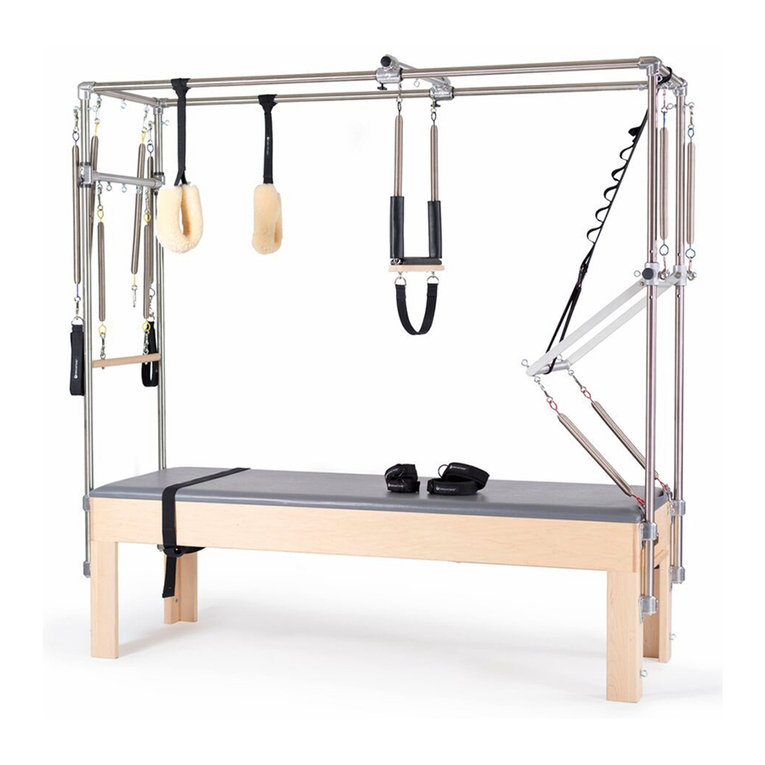
Balanced Body
Balanced Body Cadillac Administrator Guide

Balanced Body
Balanced Body Clinical Reformer User manual
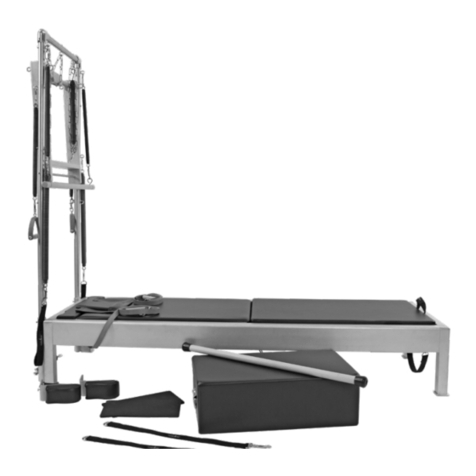
Balanced Body
Balanced Body Contrology Reformer User manual
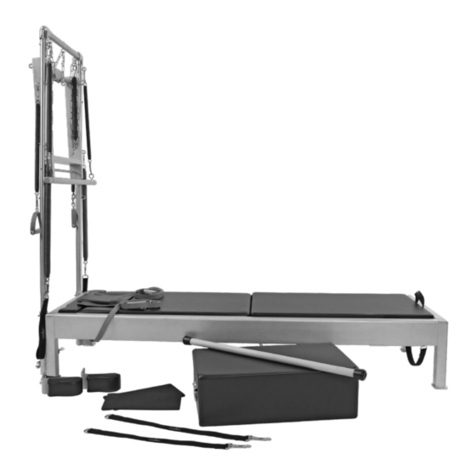
Balanced Body
Balanced Body Contrology Classical Reformer with Tower Programming manual
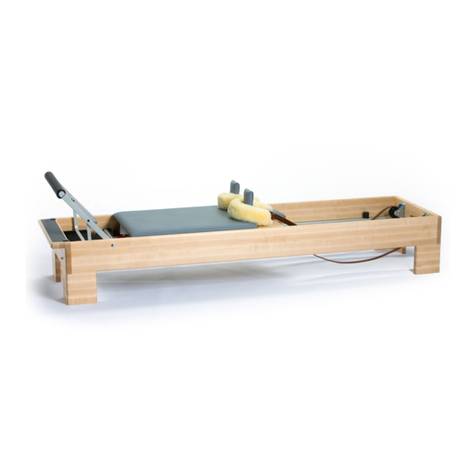
Balanced Body
Balanced Body Ron Fletcher Reformer User manual
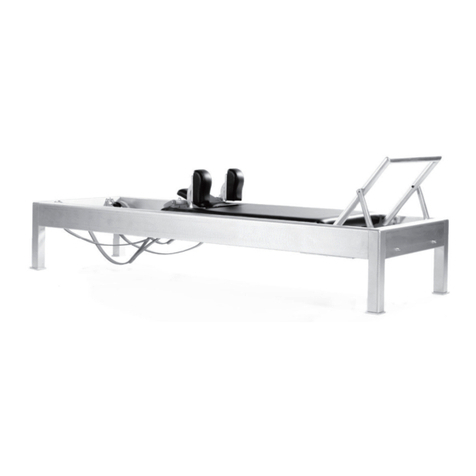
Balanced Body
Balanced Body Contrology User manual
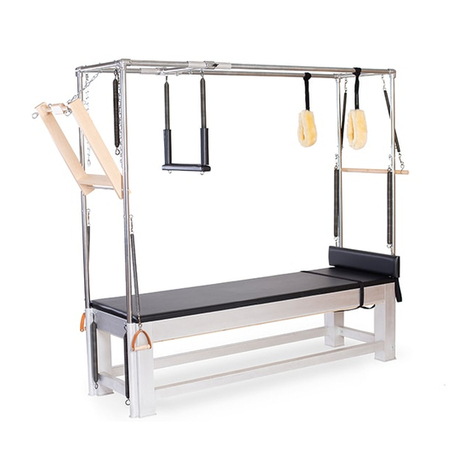
Balanced Body
Balanced Body Contrology Cadillac Administrator Guide

Balanced Body
Balanced Body Allegro 2 Reformer User manual
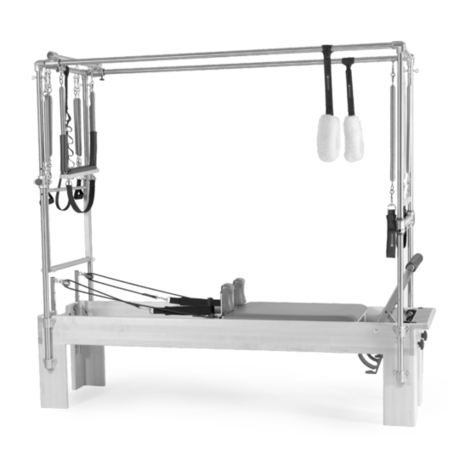
Balanced Body
Balanced Body Reformer Trapeze Combination Administrator Guide
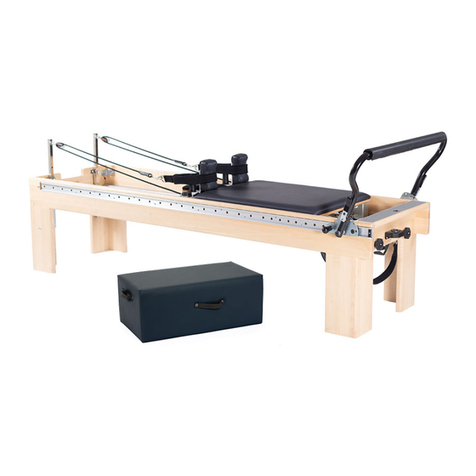
Balanced Body
Balanced Body Clinical Reformer Administrator Guide
